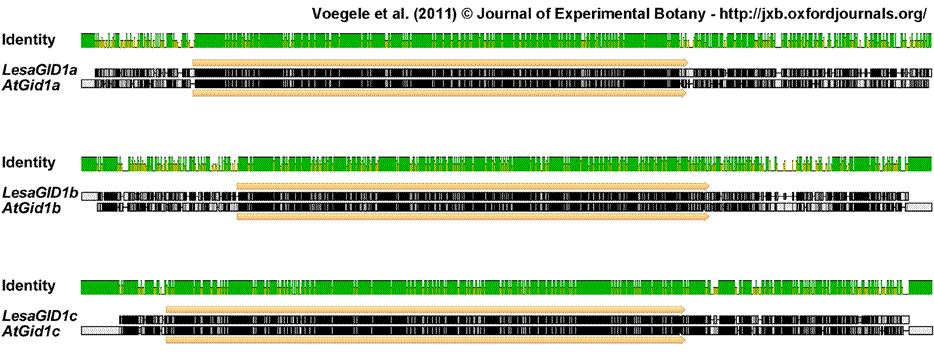Journal of Experimental Botany 62: 5131–5147 (2011)
Members of the gibberellin receptor gene family GID1 (GIBBERELLIN INSENSITIVE DWARF1) play distinct roles during Lepidium sativum and Arabidopsis thaliana seed germination [W][OA]
*Department of Biological Sciences, Simon Fraser University, 9 8888, University Drive, Burnaby BC, V5A 1S6, Canada
Received 14 March 2011; Revised 22 May 2011; Accepted 13 June 2011
Advance Acess publication 21 June 2011
DOI 10.1093/jxb/err214

Supplemental Figure S1. Transcript sequence alignments of the Brassicaceae GID1 family members of Lepidium sativum (LesaGID1a, LesaGID1b, LesaGD1c) and Arabidopsis thaliana (AtGID1a, AtGID1b, AtGID1c).
Full-length coding sequences including 5´ and 3´ UTR-sequences of GID1a, GID1b, and GID1c from L. sativum and Arabidopsis were aligned using the Geneious Alignment Algorithm (gap open penalty: 12, gap extension penalty: 3). The identity plots and the pairwise alignment of the corresponding putative cDNA orthologous sequences of the two species are presented. Different vertical colouring represents the identity at each base position between the two sequences: black = the bases at these positions are identical,
grey = base positions that are only present in one of the sequences, white = the bases at these positions are not identical. The coding sequences are indicated as orange arrows. Nucleotide coding sequence similarity between the corresponding orthologous sequences from L. sativum and Arabidopsis are 91.4% for the GID1a, 89.4% for the GID1b, and 91.0% for the GID1c sequences.
| Article in PDF format (1.5 MB) Supplementary data file (6.5 MB) |
|
|
|
The Seed Biology Place |
Webdesign Gerhard Leubner 2000 |